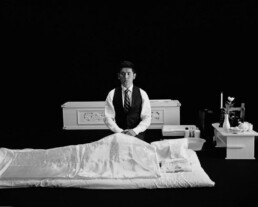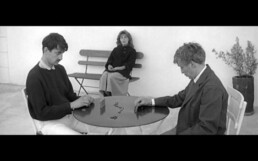Thanatological damage or immediate death.
[:it]The 'tanatological damage' must be brought within the sphere of moral damage, in its broadest exception, i.e. as the suffering of the subject who consciously witnesses his or her own death.
On this point, the most authoritative jurisprudence teaches that the so-called "Thanatological damage"or immediate death must be brought within the dimension of non-pecuniary damage, understood in its widest exception, as the suffering of the victim who lucidly witnesses the extinguishing of his or her life and, therefore, can only be such that of the victim surviving at least for an appreciable length of time after the accident and before the final outcome.
Hence, the claim for damages from "loss of the right to life"or 'tanatological damage', brought jure hereditatis by the heirs of the deceased, is not admissible when the occurrence of the fatal event takes place immediately or a short time after the harmful event, since this entails the loss of the legal asset of life in the person's hands, which cannot result in the simultaneous acquisition in the victim's estate of a corresponding right to compensation, then transferable to the heirs.
There have also been quite recent rulings on this point, and among these we can mention, in particular, the Court of Rovigo which verbatim reads '... the non-pecuniary damage jure ereditaria cannot be recognised ... because A.R. suffered intensely for less than an hour ... circumstance that, although touching from a 'moral' point of view, does not fulfil the prerequisites required by the Supreme College to consider that the right to claim has entered the legal sphere of the injured party: an appreciable period of time ...".[1]
To conclude, in hypotheses such as the one above, only one damage could be identified, namely that consisting in the suffering endured by the victim's relatives over the death of their relative.
The Supreme Court recently pronounced on this issue, confirming a well-established jurisprudential direction.
"Injury to the right to health occurs when the person remains alive with an impairment and only when there is a time lapse between the harmful event and death that makes the right to compensation accrue, which is consequently transmissible to the heirs. Consequently, compensation for tanatological damage "iure hereditatis" does not arise when death occurs immediately as a consequence of the injury, since in this case there is no injury to the legal right to health.".[2]
ABSTRACT
- the 'tanatological damage' or 'immediate death damage' must be brought within the dimension of moral damage, understood in its broadest exception, as the suffering of the victim who lucidly witnesses the extinguishing of his or her life
- the claim for damages for 'loss of the right to life' or 'tanatological damage' brought by the heirs of the de cuiusis not permissible when, the occurrence of the fatal event takes place immediately or a short time after the harmful event
- in the event of immediate or near-immediate death, damage that could be identified in the relatives of the victim would consist of the damage resulting from the suffering suffered by them due to the death of their relative
[1] Court of Rovigo - Sez. Dist. Di Adria - 02.03.2010
[2] Cass. Civ. 2010, no. 79In the same sense, Cass. Civ. 2009, no. 458; Trib. Milan, 10.4.2008, no. 4954
[:]
Burden of proof in the event of a claim for non-performance. United Sections and minority orientations.
[:it]On the subject of civil liability, the question of the burden of proof of the creditor acting in order to claim the non-performance of an obligation has seen the jurisprudence and doctrine heavily engaged, especially before the advent of the judgment of the S.ections of the Supreme Courtwhich intervened in order to
define a jurisprudential contrast.
The two guidelines are briefly recalled:
The majority one held that the aggrieved party also has the burden of proving the fact giving rise to the termination, i.e. the non-performance and the circumstances pertaining thereto, according to which it takes on legal significance, it therefore remaining for the defendant to prove the absence of fault only if the plaintiff has actually proved the fact constituting the non-performance.[1]
This orientation was mainly based on the distinction between the remedies provided for in Art. 1453 of the Civil Code (performance, termination, damages). It was observed that while in an action for performance the constitutive fact is the title, in an action for termination there are two constitutive facts: the title and the non-performance. Therefore, the evidence required under Art. 2697 of the Civil Code is different because the constitutive facts are themselves different. In the first case, therefore, proof of the negotiated or legal source of the right of claim will be sufficient, in the second case proof of both the title and the debtor's actual non-performance will be required.
The minority view, on the other hand, held that the burden of proof on the creditor is the same regardless of the action brought by the latter. Specifically, the creditor under Art. 2697 of the Civil Code must simply prove the negotiated or legal source of its right, whereas it is the creditor that will be burdened with proving the extinguishing fact of that right, constituted by the fact of performance.
This argument was based on the fact that the claims for performance, termination for non-performance and damages for non-performance are all linked to the same assumption, namely non-performance. This homogeneity implies that the principle of the presumption of the persistence of the right under Art. 2697 of the Civil Code, according to which once the creditor has proved the existence of a right, the burden of proving the existence of the extinction event is on the debtor, should apply to each of the cases listed in Art. 1453 of the Civil Code.
Le United Sections in 2001 Judgment No. 13533 adhered to the minority orientation, also stating that "is in conformity with the need not to make excessively difficult the exercise of the creditor's right to react to the non-performance, without, however, penalising the right of defence of the non-performing debtor, to apply the principle of traceability or proximity of proof, placing the burden of proof on the party in whose sphere the non-performance occurred".[2]
It should be noted, however, that there have recently been a number of court rulings which, in contrast to the now rather dated ruling of the Unified Sections, go on to state that "whatever the basis of the plaintiff's claim for damages, it is undoubtedly incumbent on the party claiming damages to prove not only the harmful event, but above all its causal traceability to the wrongful act of others."[3]
ABSTRACT
- According to the Unified Sections of the Supreme Court of Cassation On the subject of proof of non-performance of an obligation, a creditor suing for contractual termination, damages or performance only has to prove the source (negotiated or legal) of its right and the relevant time limit, limiting itself to the mere allegation of the non-performance of the other party, whereas the defendant debtor bears the burden of proof of the extinguishing fact of the other party's claim, which is the fact of performance.
- there are some judgments that have recently stated that On the subject of the burden of proof, on the creditor acting for performance, termination or compensation for damages, there is not only the proof of the performance of his obligation, but also the proof of the exact performance and, therefore, it would seem to be applicable also to the hypotheses of defects or non-conformity of the work, as they fall within the category of inexact performance
[1] See for example, Cass. Civ. 4285-94; 8336-90; 8435-96;124-70
[3] Court of Novara, 27/04/2010, no. 435 (in the present case, the owner of a car that caught fire has not proved that the fire was caused by a defect in the functioning of the car and/or a hidden defect and/or a problem with the car's equipment attributable to the seller); Cf. Court Nocera Inferiore, section I, 07/02/2012, 'On the subject of the burden of proofagainst the creditor acting for performance, termination or the compensation of damagethere is not only the proof performance of its obligation, but also the proof of the exact performance and, therefore, would seem to be applicable also to the hypothesis of defects or non-conformities of the work, as they fall within the category of inexact performance.
[:]
The contemplatio domini in contracts concluded by administrators.
[:it]It is an established principle in case law and doctrine that '.... even in the case of social representation, contemplatio domini is required, so that if the representative of a company does not use its name, the shop by the same concluded has no effect on the company itself
."[1]
Doctrine and jurisprudence agree that the statutory provision governed by Art. 1388 of the Civil Code (".contract concluded by the representative"), is also applicable by analogy with reference to organic representation, which can be configured precisely in relation to persons having the status of representative bodies of legal persons.[2]
Requirements for the contract entered into by the principal to be effective there are essentially three:
1) the contribution of representative power;
(2) the representative's action within the limits of the proxy;
(3) the circumstance that the third party is made aware by the agent himself of the fact that the contractual arrangement is referable to the principal (contemplatio domini);
It is therefore necessary that all three elements exist at the time of conclusion of the contract for the transaction to be effective vis-à-vis the principal, and if even one of these prerequisites is lacking, the transaction will be effective only vis-à-vis the principal.
Focusing on the fundamental requirement of contemplatio dominiit is necessary to emphasise that such an element performs the dual function of externalising the representative management relationship existing between the agent and the principal and of consequently making possible the imputation of the effects of the contract concluded in its name by the former.
According to authoritative case law, the spending of the principal's name in contracts subject to written form ad substantiam must be in express mode cannot be deduced solely from presumptive elements.
In such contracts, the principle that all essential elements of the contract must be apparent from the contract requires that the spending of the principal's name also result ad substantiam from the same document in which the contract is contained.[3]
ABSTRACT
- contemplatio domini is also required in the case of social representation
- in order for the contract entered into by the principal to be effective, the grant of representative authority is required, the representative's acting within the limits of the power of attorney, the contemplatio domini
- in contracts subject to written form ad substantiam the contemplatio must be expressly stated, as it cannot be deduced solely from presumed elements
[1] Civil Cassation, Sec. II, 30/03/2000, No 3903See also Civil cassation, sec. lav., 25/10/1985, no. 5271 ".If the representative of a de facto partnership does not use the name of the other partner or partners, the transaction concluded is effective only in respect of that representative, even if it relates to common interests or property;
[2] In this sense, DE NOVA, The contract, vol. X of the Treaty of Private Law, directed by P. Rescigno, Utet, Turin, 2002, p. 10;SANTORO-PASSARELLI, General Doctrines of Civil Law, Jovene, 1986 p. 288; in case law for all Cass., 18 June 1987, no. 5371, in Giur. it., 1989, I, 1, 1056
[3] "In contracts concluded by the agent, [...] where there has been no express mention of the agent's name, in which case the effects of the transaction are directly imputed to the agent even if the other contracting party has had knowledge of the agent's authority or interest in the conclusion of the transaction [...], any tacit contemplatio domini cannot be inferred from presumptions". (Civil cassation, sec. II, 12/01/2007, no. 433)
[:]
Art. 1451 of the Civil Code Enforceability against third parties of the simulated transaction.
[:en]Pursuant to theArticle 1415 of the Civil Code. simulation 'may not be relied on by the contracting parties, the successors in title or the creditors of the simulated alien, to the third parties which bona fide have acquired rights from the apparent owner."In essence, the rationale is to protect the third party vis-à-vis the parties by assigning prevalence to the trust that third partiesin good faith, have been able to place on the outward appearance of the contract.
Jurisprudence has pronounced itself on this matter by stating that "for the simulation not to be enforceable against third parties who in good faith have acquired rights from the apparent owner is necessary that the third party is the holder of a related or dependent legal situation or that in some way it can be influenced by the simulative agreement."[1]
Jurisprudence agrees that the concept of third in Article 1415 of the Civil Code must be interpreted broadly and broadly, with the view that sufficient that there is a mere connection or a simple dependency relationship between the third party's legal situation and the simulative agreement.
For example, one can read "....Article 1415 Para. (1) of the Civil Code must be interpreted as meaning that the simulation may not be opposed by the apparent owner against third-party purchasers in good faith, i.e. those who, on the basis of the simulated contract, obtain a favourable legal effect in ignorance of damaging the rights of others...."[2]
On this point, the same doctrine has expressed itself in complete agreement with the aforementioned jurisprudential orientation, stating that for third parties formerly Article 1415 of the Civil Code means all those who achieve a favourable legal effect on the basis of the simulated contract (and this responds to the general rule that one who creates an apparent negotiating situation cannot enforce the real situation against bona fide third parties.[3]
Moreover, this is nothing more than an application of the more general principle of the protection of trust "... The principle of the appearance of rights, which is linked to the more general principle of the protection of innocent expectations, may be invoked when there are objective elements capable of justifying the third party's belief as to the correspondence between the apparent situation and the real one...".[4]
As to the third party's good faith, it is briefly noted that doctrine[5] and case law[6] agree that the third party is relieved of the burden of proving it since this is presumptive in nature.
Finally, it is noted that in this matter, bad faith is identified not with the "mere science"of the simulation, but with the intention of facilitating the purpose in view of which the simulation was carried out.[7]
Therefore, the third party not only does not have the burden of proving its good faith, but it is up to the apparent holder to prove its bad faith.
- Under Art. 1415 of the Civil Code, the third party is protected with respect to the parties, the legislature having given precedence to the reliance that the third party, in good faith, has placed on the outward appearance of the contract
- In order for the simulation not to be enforceable against third parties who in good faith have acquired rights from the apparent owner, it is necessary for the third party to be the owner of a legal situation that is connected with or dependent on, or in some way affected by, the simulatory agreement
- The concept of third party in Article 1415 of the Civil Code must be interpreted broadly and broadly
- The third party is relieved of the burden of proving his good faith since this is presumptive in nature, so it is up to the apparent holder to prove his bad faith
[3] cf. M. Bianca: Civil Law - The Contract - Giuffré p. 667;
[5] Mengoni, Purchase at non-domination, 1949, 117 and later editions;
[6] Cass. 1949, no. 53; Cass. 1960, no. 1046; Cass. 1970, no. 349; Cass. 1987, no. 5143; Cass. 2002, no. 3102;
[7] Cass. 1986, no. 2004; Cass. 1991, no. 13260;
[:]
Lawyer's fees and competent jurisdiction.
[:it]
Recently, with the ruling of the 12.10.2011 n. 2100the Supreme Court has pronounced itself by stating that "the remuneration for professional serviceswhich is not conventionally established, is a illiquid pecuniary debtto be determined according to the professional tariff; it follows that the optional hole of the place where the obligation is to be performed (Art. 20 c.p.c., second hypothesis)'should be identified, pursuant to the last paragraph of Art. 1182 c.c.in the debtor's domicile in that same
tempo".[1]
Applying this principle to a lawyer's professional activity, the practical implications of the aforementioned judgment are evident. As is well known, in fact, Art. 20 c.p.c.which regulates as an alternative forum to the general forum of the defendant (Article 18 c.p.c.). states that 'in actions relating to rights of obligation, the court of the place where [...] the obligation in question is to be performed shall also have jurisdiction".
According to the Supreme Court, therefore, if it is not established "ab origine"The parties are entitled to the payment of the remuneration of a professional, the claim cannot be characterised as liquid since it can only be determined once the service has been rendered. Therefore, Article 1182 para. 3 of the Civil Code, which provides that ".the obligation relating to a sum of money must be performed at the domicile of the creditor at the time it is due. "
Given the non-liquid and determinable nature of the claim should instead be applied, according to the Supreme Court Article 1182 last paragraphwhich provides instead for performance of the obligation at the debtor's domicile.
This principle is clearly also applicable to the profession of lawyer. In fact, its remuneration most of the time cannot be determined in advance, especially if it concerns judicial activity, since it is not possible to foresee the actual activity to be performed in the course of the proceedings. Therefore, according to this orientation of the Supreme Court, should a lawyer proceed to recover a debt arising from his own professional activity, he will have to act at the defendant's forum ex Art. 18 c.p.c. or of the debtor ex art 20 c.p.c.
ABSTRACT
- Remuneration for professional services, which is not agreed upon, is an illiquid pecuniary debt, to be determined according to the professional tariff
- The optional forum of the place where the obligation is to be performed (Art. 20 c.p.c.) is to be identified, pursuant to the last paragraph of Art. 1182 c.c., in the domicile of the debtor
- A lawyer wishing to proceed for the recovery of his own claim must act either at the defendant's court pursuant to art. 18 c.p.c. or at the debtor's court pursuant to art. 20 c.p.c..
[:]
The legal nature of the associated firm in Italy.
[:it]
It is now well known that associated law firms are, in fact, without their own legal personalityfalling, according to case law, "toWithin those phenomena of aggregation of interests to which the law attributes the ability to act as autonomous centres of imputation of relations legal,munites of legal representation in accordance with the rules laid down in Article 36 et seq. of the Civil Code."[1]
In bankruptcythis characteristic is highly relevant. In fact, according to a constant orientation of the Supreme Court of Cassation, the associated studios have legal representation, do not claim any privileges when it comes to admission to the liabilities in bankruptcy. For the Supreme Court, the firm is not, in fact, assimilated to the individual subject favoured by the'Article 2751 bis n. 2., this right being insusceptible of analogical extension.
A possible solution to this problem would be the assignment of the claim arising out of the services rendered personally by the individual lawyer to the law firm. This condition, however, must in any event be attached and proven, since it cannot be considered, in the abstract, as a legal or natural effect of the lawyer's participation in the firm, an autonomous centre of interests.[2]
ABSTRACT
the associated Italian firm:
- is a phenomenon of aggregation of interests without legal personality, but with legal representation;
- in bankruptcy does not enjoy the privilege of Article 2751a(2)
- an assignment of the claim arising out of services rendered personally by the individual lawyer is still possible
[:]





